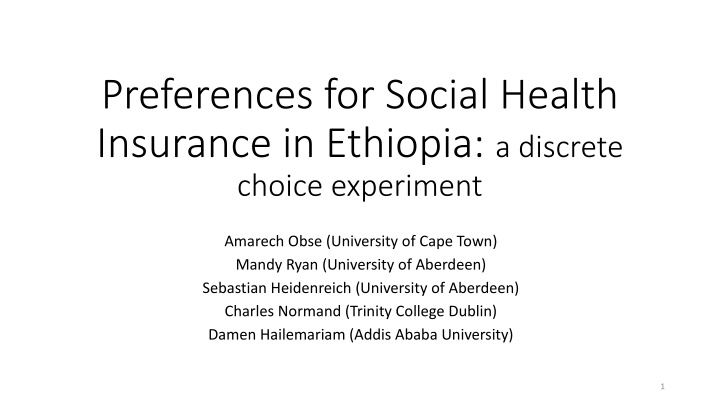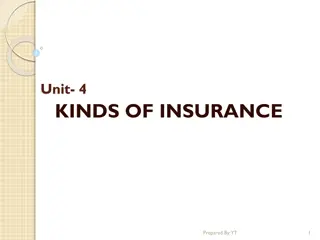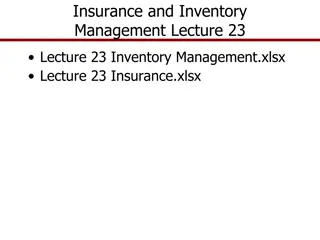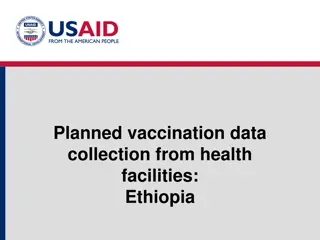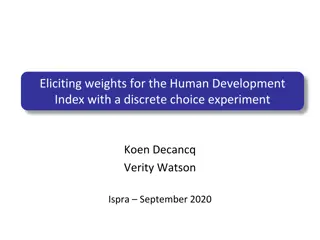Preferences for Social Health Insurance in Ethiopia: A Discrete Choice Experiment
Study conducted by Amarech Obse, Mandy Ryan, Sebastian Heidenreich, Charles Normand, and Damen Hailemariam aiming to elicit preferences for social health insurance among civil servants in Ethiopia through a discrete choice experiment. The research assesses the importance of different components of health insurance plans and estimates willingness to pay and uptake probabilities for attributes and insurance plans.
Download Presentation

Please find below an Image/Link to download the presentation.
The content on the website is provided AS IS for your information and personal use only. It may not be sold, licensed, or shared on other websites without obtaining consent from the author.If you encounter any issues during the download, it is possible that the publisher has removed the file from their server.
You are allowed to download the files provided on this website for personal or commercial use, subject to the condition that they are used lawfully. All files are the property of their respective owners.
The content on the website is provided AS IS for your information and personal use only. It may not be sold, licensed, or shared on other websites without obtaining consent from the author.
E N D
Presentation Transcript
Preferences for Social Health Insurance in Ethiopia: a discrete choice experiment Amarech Obse (University of Cape Town) Mandy Ryan (University of Aberdeen) Sebastian Heidenreich (University of Aberdeen) Charles Normand (Trinity College Dublin) Damen Hailemariam (Addis Ababa University) 1
Outline Background Objective Methods Results Discussions 2
Background Health Care Financing in Ethiopia Health Financing strategy Why Too little resources for health Per capita USD 4.5 (1995/96), USD 20.8 (2010/11) Over-reliance on out of pocket payments 52.6% of THE (1995/96), 33.7 % THE (2010/11) Inefficient and inequitable use of resources Rationale Serious decline in health care delivery Government financing is not sufficient Assess alternative methods of financing Federal Ministry of Health. 1998. Health care and financing strategy. Addis Ababa. Federal Ministry of Health. National health accounts (I-V). Addis Ababa Ethiopia 3
Background Health Care Financing in Ethiopia Health financing reform components First generation Revenue retention and utilization Systematizing the fee waiver system and exemption scheme Establishment and operation of governing boards. Outsourcing of non-clinical services. Establishment of private clinics/wings/rooms in public hospitals Birhane Y. 2008. Medical doctors profile in Ethiopia: production, attrition, and retention. In memory of 100-year Ethiopian modern medicine and the new Ethiopian millennium. Ethiopian Medical Journal, 1, 1-17 Federal Ministry of Health. 1998. Health care and financing strategy. Addis Ababa. 4
Background Health Care Financing in Ethiopia Second generation Community based health insurance for people in the informal sector. Piloting under way Social Health insurance (SHI) for formally employed SHI strategy (2008) Legal frameworks Health insurance agency 5
Objective Eliciting preferences to SHI among civil servants to: assess the importance of different components of the health insurance plans estimate the willingness to pay and/or uptake probabilities for attributes and insurance plans 6
Method Sample: civil servants from Addis Ababa Discrete choice experiment Attribute and levels: 8 attributes Experimental design: orthogonal main effects only; Choice sets: 16 binary choice sets Questionnaire: self administered Respondents: 250 civil servants Data analysis: mixed logit model Self administered questionnaire Ryan M, Gerard K, Amaya-Amaya. 2008. Using discrete choice experiments to value health and health care. Dordrecht. Springer 7
Attributes and levels Attributes Definition Levels Premium Monthly contribution as % of salary (1) 5%, (2)3%, (3) 2%, (4) 1% Exclusions Services which will not be covered by SHI (1) None (2) Dialysis (3) Dental care (4) Both Dialysis Providers Service providers for beneficiaries of SHI (1) Public providers (2) Public and private providers (3) Private providers Enrolment Family members that will be enrolled in SHI (1) Extended family, (2) Core family Coverage outpatient Level of coverage for outpatient services (1) 100% coverage , (2) 90% coverage Coverage - inpatient Level of coverage for inpatient services (1) 100% coverage , (2) 90% coverage Coverage drugs Level of coverage for drugs (1) 100% coverage , (2) 90% coverage Coverage tests Level of coverage for diagnostic tests (1) 100% coverage , (2) 90% coverage 8
Example of a choice set Attributes Insurance A Insurance B Contribution from monthly salary 3% of salary 2% of salary Enrolment Extended family Extended family Exclusion Dental & dialysis care Dental care Provider of the services Private Public & private Coverage of outpatient service 100% coverage 90% coverage of inpatient service 100% coverage 90% coverage of drugs 90% coverage 100% coverage of laboratory tests &other diagnostics 90% coverage 100% coverage Which insurance would you choose? (Please tick one box only) 9
Results Characteristics of respondents No. (%) Gender (N=208) Male 119 (57.21) Female 89 (42.79) Age group 20 29 years 105 (50.48) 30 39 years 61 (29.33) 40 49 years 36 (17.31) 50 59 years 6 (2.88) Marital status Never married 101 (48.56) Married 103 (49.52) Mean salary In Birr 2757.48 In USD ($1 = 18.4 Birr) $149.86 10
Mixed logit regression result Attributes Coefficient WTP in % salary (95% CI) Premium -0.23 *** Exclusions No exclusion 0.56 *** 3.92 (2.80, 5.05) Dialysis -0.06 1.30 (0.68, 1.91) Dental care -0.14 * 0.92 (0.07, 1.76) Dialysis and dental care+ -0.36 *** - Providers of services Public and private 0.30 *** 1.52 (0.71, 2.32) Public -0.25 ** -0.84 (-1.42, 0.27) Private+ -0.05 *** - Full coverage of drug 0.07 *** 0.62 (0.04, 1.19) Full coverage of outpatient services -0.02 ** -1.73 (-2.54, 0.91) Full coverage of inpatient services -0.01 Full coverage of tests 0.07 ** 0.63 (0.25, 1.01) Enrolment of extended family -0.06 ** -0.53 (-1.07, 0.002) 11 Constant 0.41 *** 3.49 (1.93, 5.05)
Trade-offs Trade-offs Premium (% of salary) 3 Providers Exclusion Prob. of uptake WTP (%) 1 Private None 0.31 3.92 (0.28, 0.34) 0.27 (0.24, 0.32) 0.41 (0.37, 0.45) 0.36 (0.29, 0.42) 0.28 (0.24, 0.33) 0.36 (0.32-0.40) 0.29 (0.25, 0.33) 0.21 (0.16, 0.25) 0.51 (0.45, 0.56) (2.80, 5.05) 5.44 (3.77, 7.11) 3.08 (1.81, 4.35) 5.44 (3.77, 7.01) 2.44 (1.61, 3.26) 1.52 (0.71, 2.32) 1.52 (0.71, 2.32) 0.07 (-0.74, 0.89) 3.92 (2.80, 5.05) premium and providers 2 5 Public & private None 3 1 Public None 4 5 Public & private None premium and exclusions 5 3 Public & private Dental care 6 1 Public &private Dialysis & dental care 7 3 Public & private Dialysis &dental care Coverage and provider 8 3 Public Dental care 9 3 Private None 12
Uptake probabilities An increase in premiums can be tolerated if there is choice of providers or better coverage 13
Discussion Comprehensiveness of benefit packages are more important in the design of SHI followed by providers of services and monthly contribution The willingness to pay for a typical health insurance plan of SHI strategy is lower (1.52%) than the level of contribution proposed (3%) by the strategy Uptake probability of a the typical health insurance plan was also found to be low (29%) 14
Discussion Design of health insurance plans in sub-Saharan Africa usually does not consider preferences of beneficiaries leading to dissatisfaction and welfare loss Voluntary insurance low enrolment for voluntary health insurance (De Allegri et al 2006; Basaza et al. 2007 Compulsory difficulty in compliance, low utilization, and self-referral (Carrin et al. 2007) Basaza et al. 2007. Low enrolment in Ugandan community health insurance schemes: underlying causes and policy implications. BMC Health Services Research 7:105 Carrin et al. 2007. Health financing reform in Kenya: assessing the social health insurance proposal. SAMJ 97:130-5 De Allegri et al. 2006. Understanding consumers preferences and decision to enrol in community-based health insurance in rural West Africa. Health Policy 76:58-71 15
Policy implications Overall there is lower acceptance of the SHI among civil servants, this may lead to compliance challenges during introduction of SHI; therefore, there is a need to consider preferences of beneficiaries Lower contribution rates with copayments may be further investigated and considered Further studies are needed to assess the reasons for lower acceptance of SHI 16
Thank you 17
